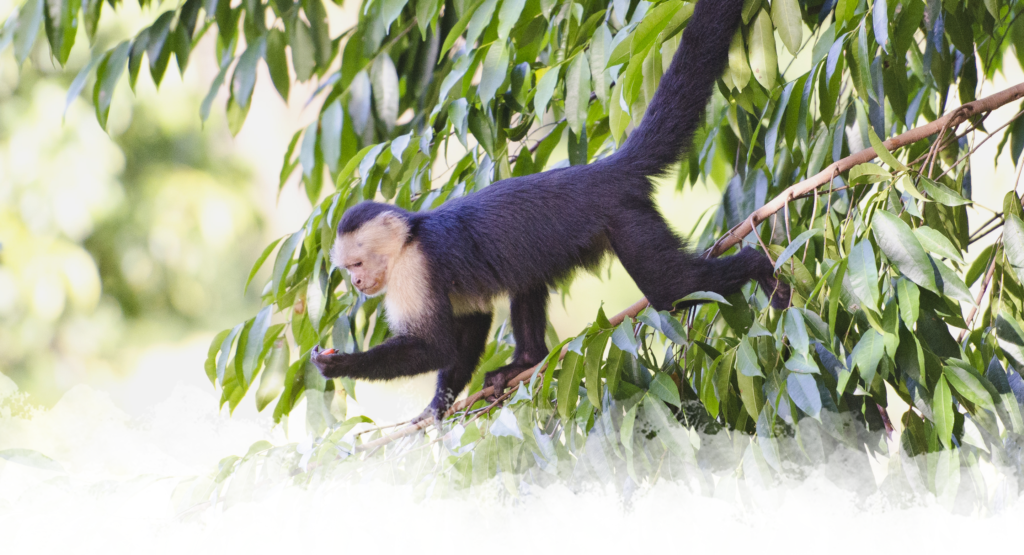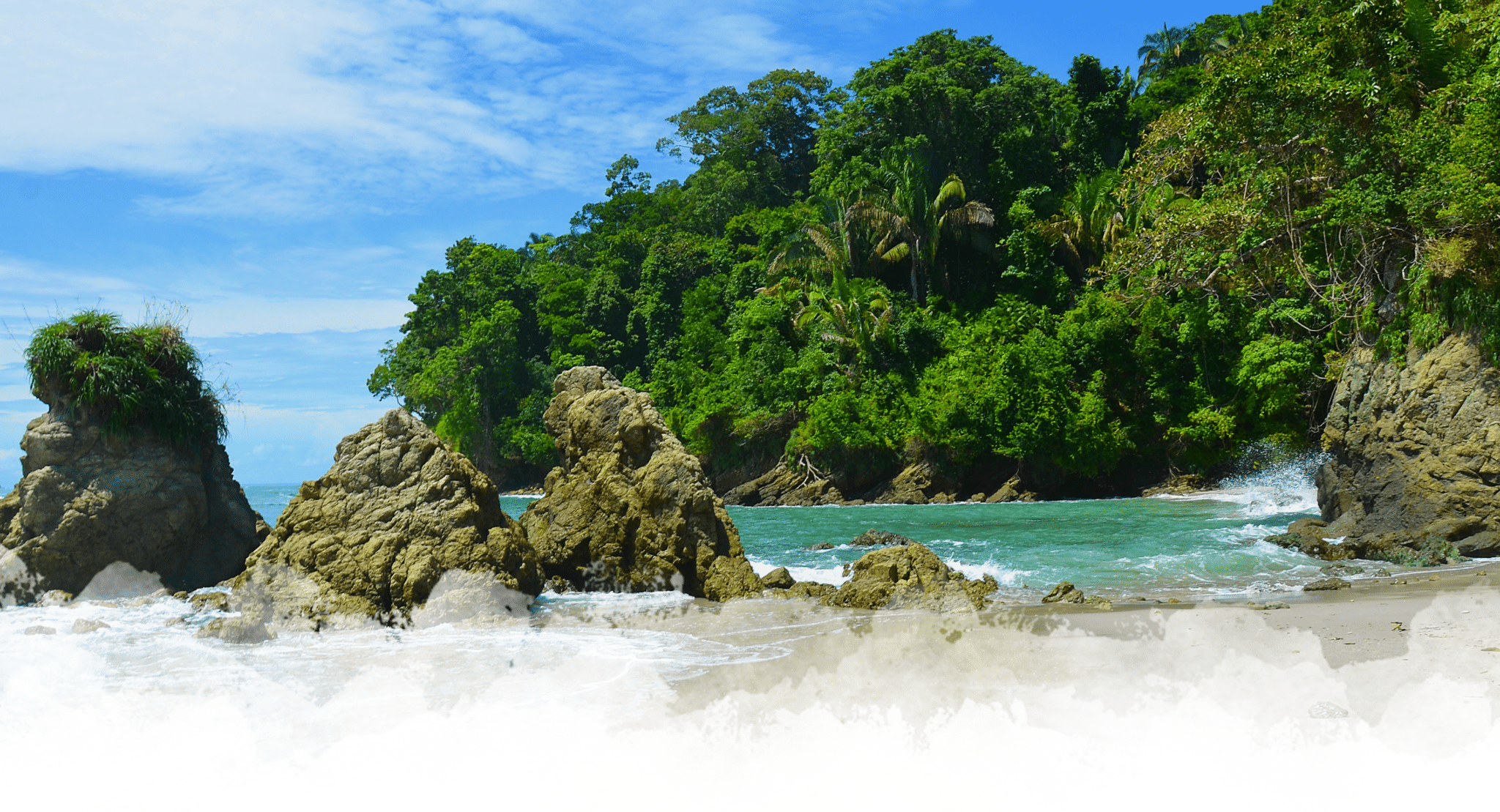Coolest Animals of Costa Rica (+ Where to Find Them), According to a Local Expert Wildlife Guide
Costa Rica’s incredible biodiversity and lush landscapes make it a dream destination in Central America for wildlife lovers. To uncover the coolest animals among Costa Rica’s natural treasures, we spoke with local wildlife expert Milenlli “Mile” Araya Masis, owner of Milentours and partner of Villa Punto de Vista in Manuel Antonio. With years of experience as a naturalist guide, Mile has a deep passion for the animals and ecosystems of Costa Rica. She’s introduced our guests to endemic species, frog species, butterfly species, the Jesus Christ lizard (they actually walk on water), green iguanas, great green macaws, and other Costa Rican animals than we can count.
She gave us insight into the most interesting species in Costa Rica and the best places to find them. But first, her story and more on the animals in Costa Rica!
Meet Mile of Milentours, Expert Costa Rican Wildlife Guide
Born in San José, Costa Rica’s capital, Mile has always had a love for nature. “I traveled all over Costa Rica as a little girl and was always passionate about animals and biodiversity,” she shared. Her passion led her to study natural resources management at one of the best universities in Costa Rica, UNED, and obtain licenses as a general guide and a naturalist guide.
Mile moved to Quepos in 2005, where she has since been involved in reforestation projects and conservation efforts and specializes in mangrove ecosystems. She leads tours in the area, showing travelers the wonders of Costa Rica’s wildlife and teaching students about ecosystems and the importance of environmental conservation. Mile also leads tours in Costa Rica’s national parks, which are key locations for experiencing the country’s remarkable biodiversity.
Many of our guests share how incredible the up-close experience with Costa Rica’s wildlife is when traveling with Mile. She knows exactly where to find the creatures hiding in plain sight, has incredible relationships with other local guides who give the inside scoop on the best spots, and is simply a joy to spend a day with. Many say they wouldn’t have seen even half of the sweet creatures she shared with them because of her expertise and eye.
From monkeys to macaws, she’ll help you discover the magic of Costa Rica’s incredible animal kingdom.
Background on the Incredible Wildlife in Costa Rica
Before we dive into what Mile thinks you should explore, it’s important to share a bit of background on the animals in Costa Rica and the immense biodiversity.
We boast over 500,000 species of animals in Costa Rica, which accounts for approximately 4% of the world’s total estimated species. Our place in Central America is home to a wide variety of wildlife, including monkeys, sea turtles, colorful birds, and many more. With its diverse ecosystems, ranging from rainforests to cloud forests and coastal areas, Costa Rica provides a unique habitat for its vast array of wildlife. The country’s commitment to environmental preservation has led to the protection of around 25% of its land and 30% of its ocean territory, making it an ideal destination for wildlife enthusiasts.
Fun fact: Villa Punto de Vista is a nature reserve itself
In fact, Villa Punto de Vista itself sits on just over two acres, but we’ve developed less than 25% of it. Our goal is to provide a natural habitat and home for these creatures who called this park home well before we did. Because of this, our guests have a unique opportunity to see much more natural wildlife than those who stay in other villas or hotels in more gated and overdeveloped areas.
The Coolest Animals to Spot in Costa Rica
Now… which animals does she think are the coolest? She gave us the inside scoop and some of her best shots.
Costa Rica is home to a variety of fascinating creatures, including the vibrant poison dart frogs, known for their small size and unique characteristics. Another famous amphibian in the region is the red-eyed tree frog, celebrated for its striking appearance and popularity among wildlife enthusiasts.
Scarlet Macaws (Ara macao)
Where to Spot Them: Near Villa Punto de Vista and Quepos
One of the most colorful birds in Costa Rica, these vibrant red, blue, and yellow birds bring a burst of color to the treetops. Reintroduced to the area after conservation efforts, Scarlet Macaws are stunning representatives of Costa Rica’s biodiversity. “They even have the colors of our national flag,” Mile points out. You’ll often see them around Villa Punto de Vista. If you sit on the rooftop deck long enough, you’ll almost certainly see some flying by!
Another great place to spot them is on the Villa Vanilla Spice Farm tour. The local guide, Joyce, can perfectly mimic the call of a scarlet macaw, which often attracts them to the farm. You’ll almost always see two at once as they are a species that mates for life.
Birds of Costa Rica
Where to Spot Them: Across Costa Rica, particularly in national parks and protected areas
Costa Rica is a birdwatcher’s paradise, with hundreds of species showing off a vast array of colors, sizes, and songs. “Birds, in general, are beautiful here in Costa Rica, with so much color and diversity,” says Mile. Whether you’re spotting hummingbirds or hawks, the vibrant avian life adds magic to any nature walk.
White-faced Capuchin Monkeys (Cebus imitator)
Where to Spot Them: Manuel Antonio National Park and throughout Costa Rica, and the villa’s pool deck
White-faced Capuchins are known for their intelligence and playful behavior. These curious monkeys are social creatures, and their clever antics make them some of the most engaging wildlife to observe. You’ll often spot them leaping through the trees in national parks and wildlife areas, including those near Quepos.
But what’s really special is we have many at the villa, too! Because we’re located in a wildlife corridor, our villa is a part of their daily commute to the park. Throughout our property you’ll see blue ropes in the trees. These are placed so the monkey species that frequent the area around the villa have a way to get around that isn’t the power lines.
Perhaps the most common Costa Rican mammals, there are a few other species you can see locally, like spider monkeys, howler monkeys, and squirrel monkeys. Both are known for their agility and social nature. They are all fascinating to watch due to their intelligence and are often seen in areas where conservation efforts are in place to protect their habitat.
Mantled Howler Monkey (Alouatta palliata)
Where to Spot Them: Manuel Antonio, Tortuguero, and Guanacaste regions
On that note, Mile said she also loves to come across this specific kind of howler monkeys. Known for their loud, barking calls, Mantled Howler Monkeys are often heard before they are seen. These powerful calls can carry for miles, leading some to believe a larger animal is in the jungle. These monkeys are among the largest in Costa Rica, making them a captivating sight in the wild.
Three-Toed and Two-Toed Sloths
Where to Spot Them: Manuel Antonio National Park, Tortuguero, and Monteverde Cloud Forest
Sloths are one of Costa Rica’s most iconic animals. There are two species found here – both two toed and three toed sloth. And for many of our guests, spotting these famously slow-moving creatures is a treat. Each species has unique characteristics, and they are incredibly adapted to their jungle habitats. Watching a sloth lazily lounge in the canopy is a must-do in Costa Rica.
Silky Anteater (Cyclopes dorsalis)
Where to Spot Them: Mangrove forests of Damas Island
The Silky Anteater is a rare and lesser-known resident of Costa Rica’s mangrove ecosystems. Mile calls this tiny anteater one of her favorites. “It’s the smallest anteater in the world, and not many people know about it,” she says. For the best chance of spotting one, take a kayak or boat tour through the mangroves of Damas Island.
Central American Squirrel Monkeys (Saimiri oerstedii)
Where to Spot Them: Pacific coast of Costa Rica, especially around Manuel Antonio and Quepos
Only found in Costa Rica and Panama, the Central American Squirrel Monkey is the rarest monkey species in the country. They are playful, small, and distinctive, making them a delight to spot. For those staying at Villa Punto de Vista, keep an eye out around the property and in nearby forests for these unique primates.
Snakes
Where to Spot Them: Throughout Costa Rica, including the rainforests around Quepos and Manuel Antonio
Snakes may not be everyone’s favorite, but Costa Rica’s diverse species—from the colorful, non-venomous ones to the elusive eyelash viper—are fascinating and beautiful. According to Mile, each snake species has unique traits and beauty, making them a thrilling find for adventurous wildlife watchers.
Those who go on tour with Mile will get the chance to see some of the most elusive species of snakes in Central America because she has an eye that can spot even the most camouflaged creatures.
How to Spend Time with Mile While at Villa Punto de Vista
As one of the expert wildlife guides Villa Punto de Vista works with the most, Mile brings her passion for Costa Rica’s incredible biodiversity to every tour she leads. Spending time with her offers guests a unique, immersive experience filled with fascinating wildlife encounters and insights into Costa Rica’s rich natural heritage.
Here’s a look at the incredible excursions she offers that your pre-arrival concierge can help you organize for your entire group or just a select few who want to experience Costa Rica animals up close and personal:
- Manuel Antonio National Park Tour: Perhaps the most popular option with our guests is a private tour of Manuel Antonio National Park. No huge groups – just you, your guests, and Mile! With her incredible expertise, you’ll get a personalized tour through the trails (which are handicap accessible), learning about the ecosystems, spotting hidden animals, and gaining insight into the delicate balance of the rainforest. Her sharp eye and knowledge ensure you won’t miss the park’s incredible sights.
- Damas Island Mangrove Tour: Explore the mysterious and serene mangrove forests of Damas Island with Mile by kayak or boat. These unique ecosystems are only about 30 minutes away from the villa and home to an array of rare wildlife, including the elusive silky anteater, mangrove boas, and vibrant mangrove warblers. Mile’s expertise in the mangroves provides a one-of-a-kind experience, as she shares the complex web of life that exists in these tidal forests. Glide through the peaceful channels while learning about the delicate interplay between land and sea in this biodiverse region.
- Turtle Releases (July to December Only): Witnessing a sea turtle release is a once-in-a-lifetime experience, and Mile can guide you through this awe-inspiring event during Costa Rica’s turtle season. From July to December, guests have the opportunity to see baby sea turtles make their way from the sand to the ocean. Mile will explain the conservation efforts involved and share her knowledge of these ancient mariners. Watching the tiny turtles begin their life journey is both moving and educational, an unforgettable way to connect with nature’s cycles.
Top National Parks for Wildlife Viewing
Costa Rica’s national parks play a crucial role in preserving the country’s remarkable biodiversity and offer exceptional wildlife viewing opportunities. Some of the top national parks for wildlife viewing include:
- Corcovado National Park: Known for its incredible biodiversity, Corcovado is home to a wide range of wildlife, including monkeys, sloths, and toucans. This park is often referred to as one of the most biologically intense places on Earth, making it a must-visit for any wildlife enthusiast.
- Manuel Antonio National Park: While we’re a bit biased, Manuel Antonio is our favorite national park. Manuel Antonio National Park is famous for its beautiful beaches and lush rainforests, which are home to a variety of wildlife, including monkeys, sloths, toucans, snakes, bats, three toed sloths and two toed sloths, and more. The park’s compact size makes it easy to explore, and its diverse habitats ensure that visitors can see a wide range of Costa Rican animals.
- Palo Verde National Park: Located in the north of Costa Rica, Palo Verde is a haven for birdwatchers, with over 300 species of birds documented in the area. The park’s wetlands and dry forests provide a unique environment for wildlife, making it a fascinating destination for nature lovers.
- Tortuguero National Park: Accessible only by boat or plane, Tortuguero is a remote park that is home to a wide range of wildlife, including monkeys, sloths, and sea turtles. The park’s network of canals and rivers offers a unique way to explore its diverse ecosystems and observe its abundant wildlife.
Wildlife Photography Tips in Costa Rica
Costa Rica is a paradise for wildlife photographers, with its lush rainforests, exotic animals, and vibrant culture. Here are some tips to help you capture the best shots of Costa Rica’s incredible wildlife:
- Know Your Equipment: Familiarize yourself with your camera and lenses before heading out on a photography adventure. A telephoto lens (at least 200mm) is essential for capturing distant subjects, while a wide-angle lens is perfect for landscape shots. Understanding your gear will help you react quickly to fleeting wildlife moments.
- Research and Planning: Study the behavior and habitats of the animals you want to photograph. Plan your itinerary according to the best times and locations for spotting specific species. For instance, early mornings and late afternoons are often the best times to see active wildlife.
- Be Patient and Quiet: Wildlife photography requires patience and stealth. Move slowly and quietly to avoid scaring away your subjects. Sometimes, waiting in one spot for a while can yield the best results as animals become accustomed to your presence.
- Respect the Animals: Keep a safe distance from the animals, and never touch or feed them. This will help prevent stressing them out and ensure their safety. Remember, the well-being of the wildlife should always come first.
- Shoot During the Golden Hour: The golden hour, just after sunrise and just before sunset, provides the best light for photography. The warm, soft light during these times is ideal for capturing animals in their natural habitats.
- Look for Interesting Behaviors: Instead of just capturing portraits, try to capture interesting behaviors like hunting, mating, or social interactions. These moments tell a story and add depth to your photographs.
- Experiment with Different Angles: Don’t be afraid to experiment with different angles and perspectives. Get low, climb high, or try shooting from a unique vantage point to create more dynamic and engaging images.
- Take Advantage of Costa Rica’s National Parks: Costa Rica’s national parks, such as Corcovado National Park and Manuel Antonio National Park, offer incredible opportunities for wildlife photography. Guided tours can provide valuable insights and access to the best spots for capturing stunning images.
- Be Prepared for the Elements: Costa Rica’s tropical climate can be unpredictable. Bring rain gear, sunscreen, and insect repellent to ensure you’re prepared for any situation. Protecting your equipment from the elements is also crucial.
- Support Conservation Efforts: By supporting eco-lodges, conservation organizations, and responsible tour operators, you can help protect Costa Rica’s incredible wildlife and habitats. Your support contributes to the preservation of these beautiful creatures and their environments.
Another tip? Give the camera to Mile! Most guides in Costa Rica have mastered the art of taking photos of Costa Rica animals through the scope. They know how to get the right angle, how quickly they move, and how to position the camera to avoid the side of the lens. It’s highly impressive! A lot of the shots in this post Mile took through the scope lens.
Some of the best places for wildlife photography in Costa Rica include:
- Corcovado National Park: Known for its incredible biodiversity, Corcovado is home to monkeys, sloths, toucans, and quetzals.
- Manuel Antonio National Park: This park is famous for its beaches, rainforests, and wildlife, including monkeys, sloths, and toucans.
- Palo Verde National Park: A great spot for birdwatching and photography, Palo Verde is home to over 300 species of birds.
- Tortuguero National Park: Accessible only by boat or plane, Tortuguero is a remote park that’s home to sea turtles, monkeys, and a variety of bird species.
Some of the most iconic Costa Rican animals to photograph include:
- Red-Eyed Tree Frogs: These colorful frogs are found in the rainforests of Costa Rica and are a popular subject for wildlife photographers.
- Spider Monkeys: With their agile movements and curious nature, spider monkeys are a joy to photograph.
- Squirrel Monkeys: These small, social monkeys are found in the tropical forests of Costa Rica and are known for their playful behavior.
- Three-Toed Sloths: Sloths are a symbol of Costa Rica, and photographing them in their natural habitat is a unique experience.
- Howler Monkeys: With their loud calls and social behavior, howler monkeys are a popular subject for wildlife photographers.
- Poison Dart Frogs: These colorful frogs are found in the rainforests of Costa Rica and are known for their toxic secretions.
- Scarlet Macaws: These vibrant birds are found in the tropical forests of Costa Rica and are a popular subject for wildlife photographers.
- Sea Turtles: Costa Rica’s beaches are a nesting ground for several species of sea turtles, including the leatherback and green sea turtles.
By following these tips and respecting Costa Rica’s incredible wildlife, you’ll be able to capture stunning images that showcase the beauty and diversity of this incredible country.
Responsible Wildlife Viewing: Ethics and Best Practices
When engaging in wildlife viewing in Costa Rica, it is essential to follow responsible and ethical practices to ensure the safety and well-being of both humans and animals. Some best practices to keep in mind include:
- Keeping a Safe Distance: Always maintain a respectful distance from wildlife to avoid disturbing them or disrupting their natural behavior. This helps ensure that animals can go about their daily activities without feeling threatened.
- Not Feeding or Touching Wildlife: Feeding or touching wildlife can lead to negative impacts on their health and behavior. It is important to let animals find their own food and maintain their natural instincts.
- Respecting Natural Habitats: Avoid littering or damaging the environment. Respecting the natural habitats of wildlife helps preserve the delicate ecosystems that these animals depend on.
- Supporting Eco-Tourism: Choose responsible tour operators that prioritize animal welfare and conservation. Supporting eco-tourism helps ensure that your visit has a positive impact on the local environment and communities.
- Learning About Local Wildlife: Educate yourself about the local wildlife and their habitats. This not only enhances your appreciation of the animals you encounter but also underscores the importance of conservation efforts.
By following these best practices, visitors can help ensure that their wildlife viewing experiences in Costa Rica are both enjoyable and responsible.
Visit Us to Meet Costa Rica Animals You Can’t Find Elsewhere
We’re honored to be in the best Central American country for wildlife and hope to introduce you to some of our favorite common species soon.
At Villa Punto de Vista, we’re passionate about sharing Costa Rica’s incredible biodiversity with you—from rare species found only in this region to the enchanting creatures that call our rainforests, beaches, and mangroves home. We can’t wait to introduce you to some of our favorite animals and help create unforgettable memories of your time surrounded by Costa Rica’s natural wonders.
Ready to experience Costa Rica’s wildlife up close and spend some time learning from our team and Mile? Book your stay with us at Villa Punto de Vista and get ready for an adventure into nature you’ll never forget!

















